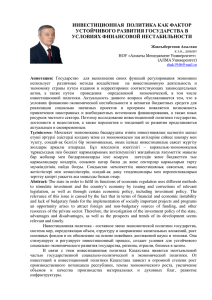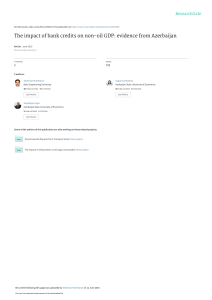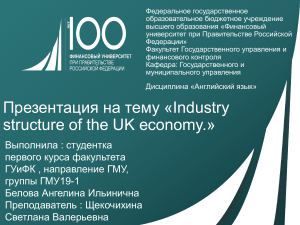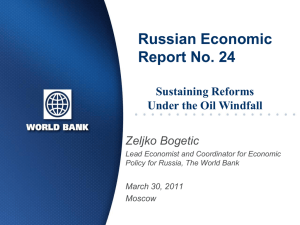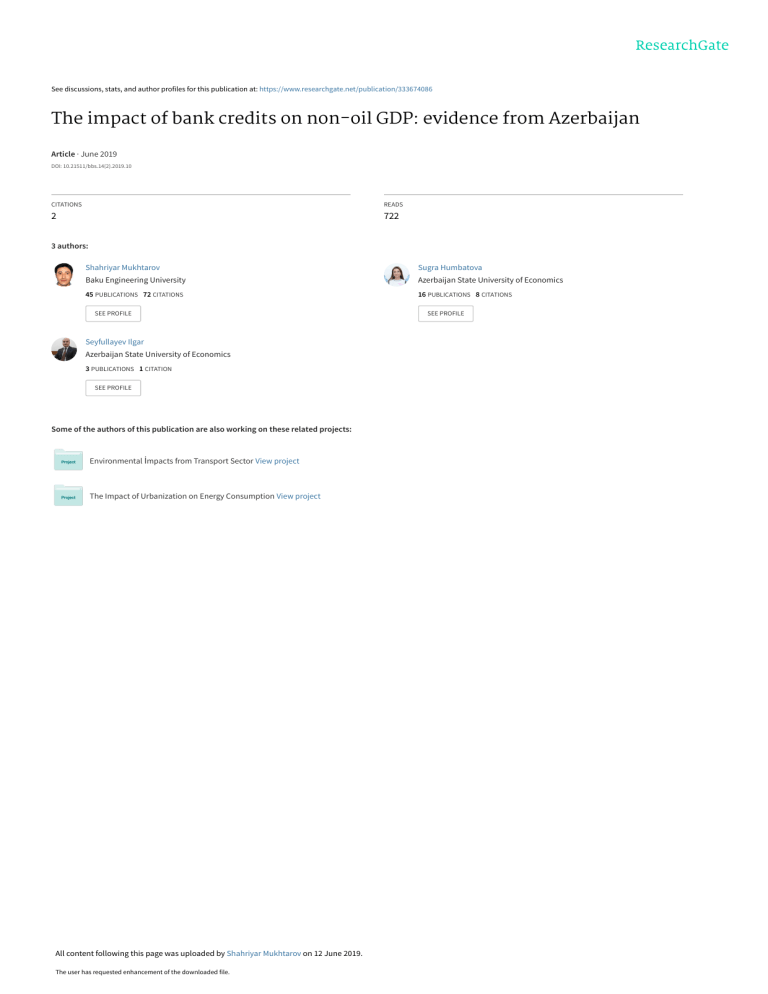
See discussions, stats, and author profiles for this publication at: https://www.researchgate.net/publication/333674086 The impact of bank credits on non-oil GDP: evidence from Azerbaijan Article · June 2019 DOI: 10.21511/bbs.14(2).2019.10 CITATIONS READS 2 722 3 authors: Shahriyar Mukhtarov Sugra Humbatova Baku Engineering University Azerbaijan State University of Economics 45 PUBLICATIONS 72 CITATIONS 16 PUBLICATIONS 8 CITATIONS SEE PROFILE Seyfullayev Ilgar Azerbaijan State University of Economics 3 PUBLICATIONS 1 CITATION SEE PROFILE Some of the authors of this publication are also working on these related projects: Environmental İmpacts from Transport Sector View project The Impact of Urbanization on Energy Consumption View project All content following this page was uploaded by Shahriyar Mukhtarov on 12 June 2019. The user has requested enhancement of the downloaded file. SEE PROFILE “The impact of bank credits on non-oil GDP: evidence from Azerbaijan” AUTHORS Shahriyar Mukhtarov Sugra Humbatova İlgar Seyfullayev ARTICLE INFO Shahriyar Mukhtarov, Sugra Humbatova and İlgar Seyfullayev (2019). The impact of bank credits on non-oil GDP: evidence from Azerbaijan. Banks and Bank Systems, 14(2), 120-127. doi:10.21511/bbs.14(2).2019.10 DOI http://dx.doi.org/10.21511/bbs.14(2).2019.10 RELEASED ON Monday, 10 June 2019 RECEIVED ON Wednesday, 24 April 2019 ACCEPTED ON Monday, 03 June 2019 LICENSE This work is licensed under a Creative Commons Attribution 4.0 International License JOURNAL "Banks and Bank Systems" ISSN PRINT 1816-7403 ISSN ONLINE 1991-7074 PUBLISHER LLC “Consulting Publishing Company “Business Perspectives” FOUNDER LLC “Consulting Publishing Company “Business Perspectives” NUMBER OF REFERENCES NUMBER OF FIGURES NUMBER OF TABLES 64 0 3 © The author(s) 2019. This publication is an open access article. businessperspectives.org Banks and Bank Systems, Volume 14, Issue 2, 2019 Shahriyar Mukhtarov (Azerbaijan), Sugra Humbatova (Azerbaijan), İlgar Seyfullayev (Azerbaijan) BUSINESS PERSPECTIVES The impact of bank credits on non-oil GDP: evidence from Azerbaijan Abstract LLC “СPС “Business Perspectives” Hryhorii Skovoroda lane, 10, Sumy, 40022, Ukraine www.businessperspectives.org Received on: 24th of April, 2019 Accepted on: 3rd of June, 2019 © Shahriyar Mukhtarov, Sugra Humbatova, İlgar Seyfullayev, 2019 Shahriyar Mukhtarov, Ph.D., Head of Department, Department of World Economy, Baku Engineering University; Department of Economics and Management, Azerbaijan State University of Economics (UNEC), Azerbaijan. Sugra Humbatova, Ph.D., Department of Economics and Management, Azerbaijan State University of Economics (UNEC), Azerbaijan. İlgar Seyfullayev, Ph.D., Department of Economics and Management, Azerbaijan State University of Economics (UNEC), Azerbaijan. This is an Open Access article, distributed under the terms of the Creative Commons Attribution 4.0 International license, which permits unrestricted re-use, distribution, and reproduction in any medium, provided the original work is properly cited. 120 This study explores the relationship between bank credits, exchange rate and non-oil GDP in Azerbaijan, utilizing FMOLS, CCR and DOLS co-integration methods to the data spanning from January 2005 to January 2019. The results from the different cointegration methods are consistent with each other and approve the presence of a longrun relationship among the variables. Estimation results reveal that there is a positive and statistically significant impact of bank credits and exchange rate on the non-oil GDP in the long run for the Azerbaijani case which are in line with the expectations and with the theoretical findings discussed in theoretical framework section. This finding also indicates that a 1% increase in credit and real exchange rate increases non-oil GDP by 0.51% and 0.56%, respectively. The results of this paper are useful for the policymakers and promote the economic literature for further researches in the case of oil-rich countries. Keywords economic growth, financial development, exchange rate, co-integration, Azerbaijan JEL Classification E44, G21, O16 INTRODUCTION In recent years, a slowdown in economic growth in developing countries and increased volatility in global financial markets make it necessary to concentrate on issues of lending to the real economy. Practice shows that large volume and growth rates of credit investments do not always generate an adequate response, sometimes stimulation of demand (for instance, subprime mortgage crisis in 2007– 2008 in the United States) and temporarily limiting the negative impact of structural problems on the economy create the illusion of economic growth. At the same time, an increase in financial losses and difficulties in meeting regulatory standards show the existence of problems in the banking sector with risk management; and the motive for profit maximization prevails over the motive to prevent risks. Moreover, when we add inefficient use of resources to these facts, we can predict systematic risks for the whole economy created by poor credit management. In Azerbaijan, the overall volume of non-performing loans amounted to AZN 0.16 billion (1 USD = 0.82 AZN), which is 2.2% of credit portfolio in 2008. However, those numbers increased to AZN 0.98 billion (1 USD = 0.78 AZN) and 5.3% in 2014 and to AZN 1.6 billion (1 USD = 1.7 AZN) or up to 12.2% in 2018, respectively (CBAR, 2019a). Only in 2017 and 2018, licenses of two banks and 42 credit organizations were terminated in Azerbaijan (FIMSA, 2019). http://dx.doi.org/10.21511/bbs.14(2).2019.10 Banks and Bank Systems, Volume 14, Issue 2, 2019 The credit risks in the economy of Azerbaijan are also increasing due to the multiplier effect of a low level of diversification. The decline in oil prices in the years 2014–2015 led to a sharp decline in economic growth, which is accompanied by a credit crisis (Mukhtarov et al., 2018). Over the past 25 years, the highest amount of loans in Azerbaijan was observed in 2015 – AZN 21.7 billion (39.9% of GDP). It was a year that the economy of Azerbaijan twice experienced the devaluation of the national currency – the exchange rate of AZN fell by almost two times against the USD (Mukhtarov et al., 2019). In the next two years, the decline in credit investments in the economy amounted to 24-28% per year. The negative trend changed only in 2018 and the volume of loans amounted to AZN 13 billion (40.1% less than the level of 2015). During the last three years, the share of loans in GDP decreased from 39.9% to 16.4% (SSCA, 2019). Of particular interest are the results of Azerbaijan in the report of the World Economic Forum on the Global Competitiveness Index for 2018. Azerbaijan’s rank is 69th among 140 countries, and its weakest positions are observed precisely in the indicators of financial sector (96th) and macroeconomic stability (126th). The 99th place in terms of volume of domestic credit to the private sector, the 92nd place in terms of soundness of banks, the 119th rank in terms of market capitalization, and the 118th rank in terms of non-performing loans show that the country has persistent problems in the field of financing economic growth. Relatively high – the 40th rank in lending to small and medium enterprises shows that loans are more available financing source for enterprises at the moment in Azerbaijan (World Economic Forum, 2018). These facts actualize research of bank credits as a tool to diversify the economy. Reducing liquidity problems and stimulating demand loans can support the non-oil sector of the economy (Humbatova & Hajiyev, 2016). From these points of view, it is concluded and hypothesized that bank credit may boost GDP. After reviewing the related studies devoted to the investigation of the impacts of financial development as proxied by the bank credits on economic growth, one can say that the financial development has a significant role in economic growth for oil-rich economies. Azerbaijan is an oil-rich country, has realized some macroeconomic and financial reforms, particularly in banking sector and faced some challenges, and 46% of its budget is being financed through transfers from State Oil Fund of the Republic of Azerbaijan. Hence, to avoid resource-based macroeconomic challenges and reach sustainable development, Azerbaijani policymakers need to develop non-oil sectors for avoiding resource based macroeconomic problems. As discussed related literature concludes, providing financial resource to non-oil sectors is one of the ways for a resource-rich economy to accelerate reforms on economic diversification to reach sustainable development. Considering the importance of the issue, this empirical study has investigated the impacts of bank credits on economic growth in the case of Azerbaijan, which is abundant by its oil and gas resources, and, one of the fastest growing economies in the last decade. The main driving forces of this remarkable economic growth are its crude oil and gas extractions that pump foreign currency to the economy and attract foreign investors. The average annual economic growth of the economy in the last 15 years is about 5%. In 2017, the share of fuel exports in the total merchandise exports was 90.1%, which indicates the strong dependency of the economy on oil and gas revenues (WB data, 2018). Considering the points mentioned above, the aim of this study is to explore the effect of bank credits on the non-oil GDP in Azerbaijan, as an oil-rich economy. According to the authors, the contributions of the current research to the literature are as follows: a) It is the first study using quarterly data which cover the period after devaluation for assessing the long-run effect of bank credits on non-oil GDP in Azerbaijan. http://dx.doi.org/10.21511/bbs.14(2).2019.10 121 Banks and Bank Systems, Volume 14, Issue 2, 2019 b) It is the first study where different co-integration methods, namely, FMOLS, CCR and DOLS are used to examine the relationship between bank credits and non-oil GDP for Azerbaijani case. c) It is the first study in the financial development-economic growth nexus, which examines the role of the exchange rate in the non-oil economic sector considering the effect of devaluation in Azerbaijan. In addition, this study is also useful for researchers and policy makers to understand the role of bank credits in economic growth for macroeconomic stability and sustainable development in Azerbaijan and other oil-rich economies. The remainder of the paper is structured as follows. The previous detailed studies are first reviewed, followed by the information about data and econometric methodology. Then the obtained results and the related discussion are provided. The last section describes conclusion and policy implications. 1. LITERATURE REVIEW Using the bank credit as a measure of financial development, Bongini et al. (2017) explored the The relationship between credits and economic impact of bank credits on the economic growth growth in the case of different countries has been for Central, Eastern and South-Eastern European investigated by a large number of studies in eco- countries. The study employed the GMM method for the time series data of 1995–2014. The estimanomic literature. tion results showed that bank credit increases ecoIn the context of credits and economic growth, nomic growth. Akpansung and Babalola (2011) evaluated the bank credit influence on economic growth in the case Aljebrin (2018) studied the impact of private secof Nigeria, employing Two-Stage Least Squares tor’s bank credits on the economic growth in Saudi (TLS) to the data spanning from 1970 to 2008. Arabia by applying the FMOLS method for the The results show a positive impact of private sec- period of 1990–2016. The study concluded a postor credit on economic growth. Iqbal et al. (2012) itive and significant long-term impact of domesstudied the impact of private saving and private tic bank credit on the economic growth. Choong credits on economic growth in Pakistan utilizing (2012) also obtained positive and statistically sigARDL technique to the data ranging from 1993 to nificant impact of credit on economic growth for 2007. They found a positive and statistically signif- 95 developed and developing economies. icant effect of credits on economic growth. The link between bank credits and economic growth Parallel to above mentioned studies, a positive was also investigated by G. Gozgor and K. Gozgor link between credits and economic growth are (2013) for twenty Latin American countries. They obtained by Banu (2013) for Romania, by Önder used panel co-integration technique for empirical and Özyıldırım (2013) for Turkey, by Timsina analysis. The results approved the presence of a (2014) for Nepal, by Osman (2014) for Saudi long-run relationship between variables. In addi- Arabia, by Yakubu and Affoi (2014) for Nigeria, tion, the employed panel causality test concluded by Samargandi et al. (2014) for Saudi Arabia, by unidirectional causality running from domestic Korkmaz (2015) for 10 European countries, by credits to economic growth. Pistoresi and Venturelli (2015) for Germany, Italy, and Spain, by Mahish (2016) for Saudi Arabia, by Ben et al. (2014) studied the relationship between Ananzeh (2016) for Jordan, by Puatwoe and Piabuo domestic credits and economic growth in Tunisia (2017) for Cameroon, by Paul (2017) for Nigeria. employing Autoregressive Distributed Lag model (ADRL) method. They revealed a positive and sig- On the other hand, Al-Zubi et al. (2006) studied nificant effect of bank credit on economic growth. the relationship between financial development Their results concluded that a 1% increase in the as proxied by the private credit and economic private credit resulted in a 3.36% increase in real growth for eleven Arab countries. For this purGDP per capita. pose, they used pooled OLS technique, random 122 http://dx.doi.org/10.21511/bbs.14(2).2019.10 Banks and Bank Systems, Volume 14, Issue 2, 2019 effect model and fixed effect model. The study concluded a negative and statistically significant effect of private credits on the economic growth. Mahran (2012) also analyzed the link between financial development and real GDP employing the ARDL model for Saudi Arabia. The study concluded a negative and statistically significant private credit impact on real GDP, either in the long- or short-run period. 2016b), Muxtarov and Mikayilov (2016) also found that bank credits are an important transmission channel of monetary policy to affect aggregate output in Azerbaijan. In the outcomes of the above-mentioned studies, there are a few studies related to the impact of bank credits on economic growth in Azerbaijan. Overall, Azerbaijan is a unique case to examine the effect of bank credits on the private sector, a Iheanacho (2016) evaluated the link between fi- proxy for financial development on the economnancial sector development and economic growth ic growth of non-oil sectors. Therefore, the main for Nigeria applying the ARDL method for the purpose of this article is to fill in this gap by emperiod of 1981–2011. The results revealed that the ploying different co-integration tests to observe credits as proxy of financial development have the long-term relationship between bank credits long-term insignificant and negative impact on and economic growth. The results of this article economic growth, while short-term significantly will suggest to researchers and policy makers to negative impact. comprehend the role of bank credits in economic growth for macroeconomic stability and sustainaIn addition, numerous studies conducted by Cevik ble development goals in Azerbaijan and other deand Rahmati (2013), Samargandi et al. (2014), by veloping oil-rich countries. Anyanwu (2014), Quixina and Almeida (2014), Adeniyi et al. (2015), and Nwani and Orie (2016) found a weak or negative link between credits and 2. ECONOMETRIC economic growth. In the case of Azerbaijan, prior research conducted by Hasanov and Huseynov (2013) examined the bank credits effect on non-oil economic growth using ARDL Bounds Testing approach, Johansen’s approach, and EngleGranger methodology. Authors found a positive impact of bank credits on non-oil economic growth. Koivu and Sutela (2005) evaluated the link between financial sector development and economic growth for 25 transition economies (including Azerbaijan) using fixed effect model and found financial development as proxied by credit increasing economic growth. Mukhtarov et al. (2018) evaluated the relationship among energy consumption, economic growth and financial development in Azerbaijan. Different co-integration methods, namely, Autoregressive Distributed Lags Bounds co-integration test, Gregory-Hansen co-integration test and Johansen co-integration test are applied to see long-run relationship among the variables. The results approve the presence of long-term relationship between financial development as proxied by bank credit, energy consumption and economic growth. Mukhtarov et al. (2016a, http://dx.doi.org/10.21511/bbs.14(2).2019.10 METHODOLOGY AND DATA For empirical analysis, the study uses monthly data over the period of January 2005 to January 2019 for the following variables: credits (CRD), real exchange rate (REXC) and non-oil GDP (NGDP). All data set have been retrieved from the Central Bank of the Republic of Azerbaijan (CBAR, 2019). Non-oil GDP is the dependent variable. The non-oil GDP is measured by non-oil sector output deflated by the consumer price index (CPI). Credits is the main independent variable, and measured by bank credits to the private sector in a million constant manats. Prior literature, like Demetriades and Hussein (1996), King and Levine (1993), Levine (2002), Oluitan (2009), Ang (2008), Jalil et al. (2010), Beck (2011), Banu (2013), Hasanov and Huseynov (2013), found that private bank credits boost the economic growth. The real exchange rate (REXC) is also used as a control variable, which may have an effect on the economic growth. The REXC is measured in national currency per US dollar. This variable was used in many previous studies, such as Egert 123 Banks and Bank Systems, Volume 14, Issue 2, 2019 (2009), Habib and Kalamova (2007), Sturm et al. Table 1. ADF unit root test results (2009), Hasanov and Huseynov (2009), Hasanov Panel A: Panel B: and Samadova (2010), Hasanov (2010, 2011), Level 1st difference Variables Hasanov and Huseynov (2013), Mukhtarov Actual Actual value value (2018), Mukhtarov et al. (2019), who found that –0.099707 –3.813951*** REXC has a significant effect on main macroe- NGDP CRD –1.593282 –12.33008*** conomic factors. All variables have been transREXC –0.218238 –9.24939`*** formed into the natural logarithmic form. The relationship between credits, exchange rate and non-oil GDP is explored utilizing the different co-integration methods in this study. In the empirical part, stationarity and unit root of variables will be tested, then the long-run co-integration relationship, and then the long-run relationship between credits, exchange rate and non-oil GDP will be estimated. The Augmented Dickey-Fuller (ADF) test by Dickey and Fuller (1981) is applied for unit root exercise, while for analyzing the co-integration relationship, the Engle-Granger test by Engle and Granger (1987), and the Phillips-Ouliaris test by Phillips and Ouliaris (1990) are utilized. Next, three co-integration methods are used to analyze the longrun relationship. First, Fully Modified Ordinary Least Squares Method (FMOLS) is used as a main tool, then Canonical Cointegrating Regression (CCR) and Dynamic Ordinary Least Squares (DOLS) methods are utilized for the robustness check. Results I(1) I(1) I(1) Note: *, ** and *** accordingly show null hypothesis rejection at 10%, 5% and 1% significance levels. For co-integration relationship, the Engle-Granger and the Phillips-Ouliaris co-integration tests are employed and results are given in Table 2. Both co-integration tests show the co-integration relationship among the variables. Table 2. Co-integration test results Tau-stat z-stat Engle-Granger Phillips-Ouliaris –7.7271 (0.00) –88.126 (0.00) –7.6433 (0.00) –85.117 (0.00) Note: p-values are provided in parentheses. Therefore, after approving the presence of co-integration among the variables, the long-run relationship can be estimated. For this purpose, FMOLS, CCR and DOLS methods are used to analyze the long-run relationship among the variables. The estimation results are provided in Table 3. Table 3. Results from different methods The above-mentioned methods are extensiveCRD REXC Constant Methods Coefficient Coefficient Coefficient ly used in vast studies, they are not discussed in (Std. err.) (Std. err.) (Std. err.) this study. The detailed information about these FMOLS 0.51*** (0.14) 0.56** (0.27) 3.85*** (1.08) methods has been mentioned in Dickey and CCR 0.51*** (0.13) 0.56** (0.27) 3.83*** (1.04) Fuller (1981), Engle and Granger (1987), Phillips 0.50*** (0.15) 0.67** (0.28) 3.78*** (1.21) and Ouliaris (1990), Phillips and Hansen (1990), DOLS Saikkonen (1992), Park (1992) and Stock, Watson Note: The dependent variable is NGDP; Std. err. means standard error; *, ** and *** show significance levels at 10% (1993), and others. 5% and 1%. In terms of significance and magnitude, the longrun coefficients of the three methods are statistically significant and close to each other. As was mentioned in the methodology section, priority First, unit root problems of the used variables are is given to the FMOLS method, the results of checked by employing ADF unit root test. Results which are presented in the first row of Table 3. of the ADF test are provided in Table 1. Table 1 The study finds a positive and statistically signifishows that all the variables are non-stationary at cant effect of bank credits on non-oil GDP at the their levels but they become stationary at first dif- 1% level. The results indicate that a 1% increase in ference. Therefore, they can be analyzed for the credits results in 0.51% increase in non-oil GDP. co-integration relationship. Regarding the financial development-economic 3. EMPIRICAL RESULTS AND DISCUSSION 124 http://dx.doi.org/10.21511/bbs.14(2).2019.10 Banks and Bank Systems, Volume 14, Issue 2, 2019 growth nexus, the results are similar to those of many previous studies like Akpansung and Babalola (2011), Hasanov and Huseynov (2013), Osman (2014), Samargandi et al. (2014), Yakubu and Affoi (2014), Mahish (2016), Paul (2017), and Aljebrin (2018), who also found a positive effect of bank credits on economic growth in oil-rich countries. It is also found that the effect of real exchange rate on non-oil GDP is positive and statistically significant at the 5% level. This indicates that a 1% increase in real exchange rate (depreciation of national currency) increases nonoil GDP by 0.56%. This result is appropriate with the economic theory. According to the theory, an increase in exchange rate (depreciation of the national currency) leads to an increase in net exports. In addition, rise in the net export resulted in increase in GDP. CONCLUSION The study examines the impact of credits and exchange rate on non-oil GDP. First, unit root problems of variables are tested. The results concluded that they are stationary at first differenced form, hence variables can be tested for the long-run co-integration relationship. Engle-Granger and PhillipsOuliaris tests confirm co-integration relationship among bank credits, exchange rate and non-oil GDP in Azerbaijan. The FMOLS, CCR and DOLS techniques are used to evaluate the long-run relationship among these variables. Estimation results of FMOLS show that credits and real exchange rate increase non-oil GDP in the long run, namely, a 1% increase in credit and real exchange rate increases non-oil GDP by 0.51% and 0.56%, respectively. The related policy implication and key findings of this study are that policymakers should focus on bank credits to boost economic growth in order to diversify economy for reaching sustainable development in Azerbaijan and also promote the economic literature devoted to economic growth and financial development in oil-rich countries. REFERENCES 1. 2. 3. 4. Adeniyi, O., Oyinlola, A., Omisakin, O., & Egwaikhide, F. O. (2015). Financial development and economic growth in Nigeria: Evidence from threshold modelling. Economic Analysis and Policy, 47, 11-21. https://doi. org/10.1016/j.eap.2015.06.003 International Development, 6(3), 137-150. Retrieved from http:// www.usc.es/economet/journals1/ aeid/aeid6311.pdf Economics and Finance, 6, 25-30. https://doi.org/10.1016/S22125671(13)00109-3 9. Beck, T. (2011). Finance and oil: Is there a resource curse in financial development? (Unpublished Working Paper). Washington, D.C.: International Monetary Fund. 5. Akpansung, A. O., & Babalola, S. J. (2011). Banking Sector Credit and Economic Growth in Nigeria: An Empirical Investigation. CBN Journal of Applied Statistics, 2(2), 51-62. Ananzeh, I. E. (2016). Relationship between bank credit and economic growth: Evidence from Jordan. International Journal of Financial Research, 7(2), 53-63. http:// dx.doi.org/10.5430/ijfr.v7n2p53 6. Aljebrin, M. A. (2018). Non-Oil Trade Openness and Financial Development Impacts on Economic Growth in Saudi Arabia. International Journal of Economics and Financial Issues, 8(5), 251-260. Ang, B. J. (2008). What are the mechanisms linking financial development and economic growth in Malaysia? Economic Modeling, 25(1), 38-53. https:// doi.org/10.1016/j.econmod.2007.04.006 10. Ben, J. K., Boujelbène, T., & Helali, K. (2014). Financial development and economic growth: New evidence from Tunisia. Journal of Policy Modeling, 36(5), 883-898. http://dx.doi.org/10.1016/j.jpolmod.2014.08.002 7. Anyanwu, J. C. (2014). Factors affecting economic growth in Africa: Are there any lessons from China? African Development Review, 26(3), 468-493. http:// dx.doi.org/10.1111/14678268.12105 11. Bongini, P., Iwanicz-Drozdowska, M., Smaga, P., & Witkowski, B. (2017). Financial Development and Economic Growth: The Role of Foreign-Owned Banks in CESEE Countries. Sustainability, 9(335), 1-25. 8. Banu, I. M. (2013). The Impact of Credit on Economic Growth in the Global Crisis Context. 12. Central Bank of Azerbaijan (CBAR). (2019 a). Retrieved from https://www.cbar.az/page-42/mon- Al-Zubi, K., Al-Rjoub, S., & Abu-Mhareb, E. (2006). Financial development and economic growth: A new empirical evidence from the MENA countries, 1989– 2001. Applied Econometrics and http://dx.doi.org/10.21511/bbs.14(2).2019.10 125 Banks and Bank Systems, Volume 14, Issue 2, 2019 etary-indicators#page-2 (accessed on March 1, 2019). 13. Central Bank of Azerbaijan (CBAR). (2019 b). Retrieved from https://www.cbar.az/page-41/macroeconomic-indicators (accessed on March 1, 2019). 14. Cevik, S., & Rahmati, M. (2013). Searching for the FinanceGrowth Nexus in Libya (IMF Working Paper No. WP/13/92). International Monetary Fund. Retrieved from https://www.imf. org/external/pubs/ft/wp/2013/ wp1392.pdf 15. Choong, C. K. (2012). Does domestic financial development enhance the linkages between foreign direct investment and economic growth? Empirical Economics, 42(3), 819-834. http:// dx.doi.org/10.1007/s00181-0110455-2 16. Demetriades, P. O., & Hussein, K. A. (1996). Does financial development cause economic growth? Time series evidence from 16 countries. Journal of Development Economics, 51, 387411. 17. Dickey, D., & Fuller, W. (1981). Likelihood Ratio Statistics for Autoregressive Time Series with a Unit Root. Econometrica, 49(4), 1057-1072. 18. Egert, B. (2009). Dutch disease in former Soviet Union: Witchhunting? CASE Network Studies and Analyses No. 380, CASECenter for Social and Economic Research. Retrieved from https:// www.files.ethz.ch/isn/98019/ CASE%20Network%20-%20 witch%20hunting.pdf 19. Engle R. F., & Granger, C. W. J. (1987). Co-integration and error correction: representation, estimation and testing. Econometrica, 55(2), 251-276. Retrieved from http://www. ntuzov.com/Nik_Site/Niks_files/ Research/papers/stat_arb/ EG_1987.pdf 20. Financial Market Supervisory Authority (FIMSA). (2019). Retrieved from https://www. fimsa.az/az/statistika (accessed on March 1, 2019). 126 21. Gozgor, G., & Gozgor, K. (2013). The Relationship between domestic credit and income: Evidence from Latin America. Applied Econometrics and International Development, 13(1), 89-98. 22. Habib, M. M., & Kalamova, M. M. (2007). Are there oil currencies? The real exchange rate of oil exporting countries (Working Paper Series No. 839). European Central Bank. 23. Hasanov, F. (2010). The impact of real oil price on real effective exchange rate: The case of Azerbaijan (Discussion Paper Series No. 1041). DIW Berlin German Institute for Economic Research Retrieved from http:// www.diw.de/documents/publikationen/73/diw_01.c.359129.de/ dp1041.pdf 24. Hasanov, F. (2011). Analyzing price level in a booming economy: The case of Azerbaijan. Economics and Educational Research Consortium (Working Paper Series No. 11/02E). Ukraine: Kiev. Retrieved from http://archive.org.ua/archive/2011-07-07/eerc.kiev.ua/ paper Economic Growth in Nigeria: An ARDL Analysis. Economies, 4(26), 1-12. http://dx.doi.org/10.3390/ economies4040026 30. Iqbal, M. Z., Ahmad, N., & Hussain, Z. (2012). Impact of Savings and Credit on Economic Growth in Pakistan. Pakistan Journal of Social Sciences, 32(1), 39-48. 31. Jalil, A., Feridun, M., & Ma, Y. (2010). Finance-growth nexus in China revisited: New evidence from principal components and ARDL bounds tests. International Review of Economics and Finance, 19(2), 189-195. 32. King, R. G., & Levine, R. (1993). Finance, entrepreneurship, and growth: Theory and evidence. Journal of Monetary Economics, 32, 513-542. 33. Koivu, T., & Sutela, P. (2005). Financial systems in transition: Could small actually be beautiful? Eastern Economic Journal, 31(2), 265-283. 34. Korkmaz, S. (2015). Impact of Bank Credits on Economic Growth and Inflation. Journal of Applied Finance & Banking, 5(1), 57-69. 25. Hasanov, F., & Huseynov, F. (2009). Real exchange rate misalignment in Azerbaijan (Working paper). Retrieved from http://papers.ssrn.com/sol3/papers.cfm?abstract_id=1788664 35. Levine, R. (2002). Bank-based or market-based financial systems: Which is better? Journal of Financial Intermediation, 11(4), 398-428. https://doi.org/10.1006/ jfin.2002.0341 26. Hasanov, F., & Samadova, I. (2010). The impact of real effective exchange rate on the non-oil export: The case of Azerbaijan (MPRA Paper No. 79559). Retrieved from https://mpra. ub.uni-muenchen.de/79559/ 36. Mackinnon, J. G. (1996). Numerical Distribution Functions for Unit Root and Co-integration Test. Journal of Applied Econometrics, 11(6), 601-618. Retrieved from https://www.jstor. org/stable/2285154 27. Hasanov, F., & Huseynov, F. (2013). Bank credits and non-oil economic growth: Evidence from Azerbaijan. International Review of Economics and Finance, 27(C), 597-610. 37. Mahran, H. A. (2012). Financial intermediation and economic growth in Saudi Arabia: An empirical analysis, 1968–2010. Modern Economy, 3(5), 626640. http://dx.doi.org/10.4236/ me.2012.35082 28. Humbatova, S., & Hajiyev, N. (2016). External Financing of Azerbaijan’s Agriculture. Bulgarian Journal of Agricultural Science, 22(6), 875-892. 29. Iheanacho, E. (2016). The Impact of Financial Development on 38. Mukhtarov, S. (2018). Azerbaycan Örneğinde Döviz Kuru Kanalının İşleyişi:Ampirik Bir Analiz. The Sustainable Development of Economy and Administration: Problems And Perspectives (pp. 145-149). Engineering University. http://dx.doi.org/10.21511/bbs.14(2).2019.10 Banks and Bank Systems, Volume 14, Issue 2, 2019 39. Mukhtarov, S., Hasan, S., & Mammadov, E. (2016a). Parasal Aktarım Mekanizmaları: Azerbaycan Örneği. Journal of Research in Business & Social Science, 5(2), 16-33. 40. Mukhtarov, S., Mikayilov, C., & Mammadov, Z. (2016b). Azerbaycan’da Banka Kredi Kanalının İşleyişi: Ampirik Bir Analiz. Akademik Bakiş Dergisi, 56, 475-488. Retrieved from https://dergipark.org.tr/download/ article-file/383413 41. Mukhtarov, S., Yüksel, S., & Mammadov, E. (2018). Factors that increase credit risk of Azerbaijani banks. Journal of International Studies, 11(2), 63-75. http://dx.doi.org10.14254/20718330.2018/11-2/5 42. Mukhtarov, S., Yüksel, S., Ibadov, E., & Hamidov, H. (2019). The effectiveness of exchange rate channel in Azerbaijan: an empirical analysis. Banks and Bank Systems, 14(1), 111-121. http://dx.doi.org/10.21511/ bbs.14(1).2019.10 43. Muxtarov, Ş. & Mikayilov, C. (2016). Pul Siyasətinin Transmissiya Mexanizmlərinin Azərbaycan Timsalında Yoxlanması. Journal of Qafqaz University, 4(1), 103109. Retrieved from https:// www.researchgate.net/profile/Shahriyar_Mukhtarov/ publication/305206032_ TESTING_OF_MONETARY_POLICY_TRANSMISSION_MECHANISMS_IN_ THE_CASE_OF_AZERBAIJAN/ links/57849b6908aee45b8443274d. pdf 44. Nwani C., & Orie, J. B. (2016). Economic growth in oil-exporting countries: Do stock market and banking sector development matter? Evidence from Nigeria. Cogent Economics and Finance, 4(1), 1-11. https://doi.org/10.1080/ 23322039.2016.1153872 45. Oluitan, R. (2012). Bank credit and economic growth: The Nigerian experience. International Business and Management, 5(2), 102-110. https://doi.org/10.3968/j. ibm.1923842820120502.1040 46. Önder, Z., & Özyıldırım, S. (2013). Role of bank credit on http://dx.doi.org/10.21511/bbs.14(2).2019.10 View publication stats local growth: Do politics and crisis matter? Journal of Financial Stability, 9(1), 13-25. http://dx.doi. org/10.1016/j.jfs.2012.12.002 47. Osman, E. G. A. (2014). The Impact of Private Sector Credit on Saudi Arabia Economic Growth (GDP): An Econometrics Model Using (ARDL) Approach to Co-integration. American International Journal of Social Science, 3(6), 109-117. 48. Park, J. Y. (1992). Canonical cointegrating regressions. Econometrica, 60(1), 119-143. http://dx.doi.org/10.2307/2951679 49. Paul, N. (2017). Commercial Banks’ Sectoral Credit Allocation and Growth of Nigeria Economy: An Impact Analysis (1994–2015). International Journal of Arts and Humanities, 6(4), 144-161. 50. Phillips, P. C. B., & Hansen, B. E. (1990). Statistical inference in instrumental variables regression with I(1) processes. Review of Economics Studies, 57(1), 99-125. https://doi.org/10.2307/2297545 51. Phillips, P. C. B., & Ouliaris, S. (1990). Asymptotic properties of residual based tests for co-integration. Econometrica, 58(1), 165-193. http://dx.doi. org/10.2307/2938339 52. Pistoresi, B., & Venturelli, V. (2015). Credit, venture capital and regional economic growth. Journal of Economics and Finance, 39(4), 742-761. http://dx.doi. org/10.1007/s12197-013-9277-8 53. Puatwoe, J. T., & Piabuo, S. M. (2017). Financial sector development and economic growth: evidence from Cameroon. Financial Innovation, 3(25), 1-18. 54. Quixina, Y., & Almeida, A. (2014) Financial Development and Economic Growth in a Natural Resource Based Economy: Evidence from Angola (FEP Working Papers No. 542). Retrieved from http:// wps.fep.up.pt/wps/wp542.pdf 55. Saikkonen, P. (1992). Estimation and testing of cointegrated systems by an autoregressive approximation. Econometric Theory, 8(1), 1-27. Retrieved from https://www.jstor.org/ stable/3532143 56. Samargandi, N., Fidrmuc, J., & Ghosh, S. (2014). Financial development and economic growth in an oil-rich economy: The case of Saudi Arabia. Economic Modelling, 34, 267-278. http://dx.doi.org/10.101643.econmod.2014.07.042 57. Stock, J. H., & Watson, M. (1993). A simple estimator of cointegrating vectors in higher order integrated systems. Econometrica, 61(4), 783-820. 58. Sturm, M., Gurtner, F., & Alegre, J. G. (2009). Fiscal policy challenges in oil-exporting countries: A review of key issues (Occasional paper series No. 104). European Central Bank. Retrieved from http:// www.ecb.int/pub/pdf/scpops/ ecbocp104.pdf 59. The State Statistical Committee of the Republic of Azerbaijan (SSCA). (2019). System of national accounts and balance of payments. Retrieved from https://www. stat.gov.az/source/system_nat_ accounts/?lang=en 60. Timsina, N. (2014). Impact of Bank Credit on Economic Growth in Nepal (NRB Working Paper No. 22). Nepal Rastra Bank. Retrieved from https://ideas.repec. org/p/nrb/wpaper/v22y2014p1-23. html 61. Uddin, G., Sjö, B., & Shahbaz, M. (2013). The causal nexus between financial development and economic growth in Kenya. Economic Modelling, 35, 701-707. http://dx.doi.org/10.1016/j.econmod.2013.08.031 62. World Bank (WB). (2018). World development indicators. Retrieved from https://data.worldbank.org/ indicator/ 63. World Economic Forum (2018). Global Competitiveness Report 2018. Retrieved from https://www. weforum.org/reports/the-globalcompetitveness-report-2018 64. Yakubu, Z., & Affoi, A. (2014). An analysis of commercial banks’ credit on economic growth in Nigeria. Current Research Journal of Economic Theory, 6(2), 11-15. Retrieved from http://maxwellsci. com/print/crjet/v6-11-15.pdf 127
